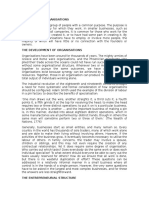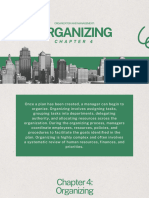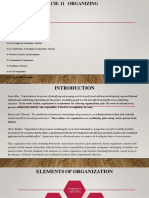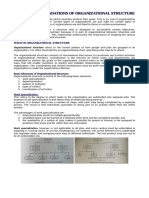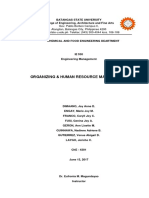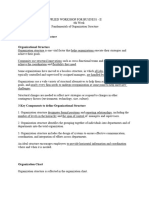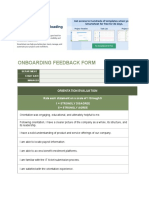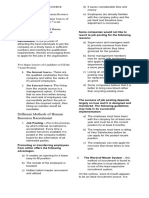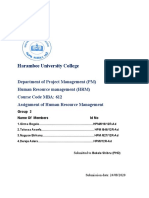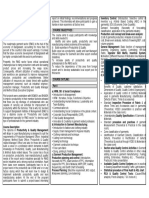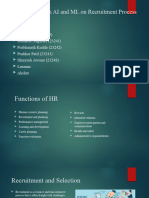ABM 11 WEEK 4 tasks have to be divided, and groups assigned to the CEO. Figure 4.
groups assigned to the CEO. Figure 4.1 also shows Some staff functions have huge responsibility
specialize in parts of the larger task. five subordinates under the CEO. This in organizations, e.g., the approving and
LESSON 4.1 FUNDAMENTALS OF
Integration is achieved with coordination, number of subordinates who report directly to monitoring activities of finance groups.
ORGANIZING
communication, and collaboration, as it an executive or supervisor is called span of
Chapter 1 showed the hierarchy levels in an involves linking parts of the enterprise into a control.
enterprise in the shape of a pyramid, without a whole. Discussion Points
Some organizations are tall, where managers
position titles or specific roles. Figure 4.1
Discussion Points have fewer subordinates, while other The students are assigned to review charts of
elucidates the chain of command or hierarchy
organizations are flat, with managers having school organizations to explain their
in the organizational chart. 1. The students are assigned to review
more subordinates. It is believed that optimal horizontal and vertical structures.
organizational charts with uneven levels or
span of control is achieved when it is (1)
hierarchies and broken lines of authority. The
narrow enough to permit managers to
differentiation and integration concepts are
maintain control over subordinates, while (2) The Functional Organization
reiterated to explain the charts.
not too narrow to permit over control over
CHIEF
EXECUTIVE 2. The students are assigned to draw an subordinates. The business functions shown in figure 4.1-
OFFICER
organizational chart of their student marketing, finance, accounting, and human
Different management levels and spans of resources-are sets of specialized skills that are
organizations or household relationships.
control allow for authority to be spread in grouped together. This type of chart shows a
MARKETING FINANCE ACCOUNTING
organizations. This is where delegation is a functional organization, where the jobs are
paramount concept. The assignment of new or grouped together in departments with the
LESSON 4.2 Organizational Structures additional responsibilities to a subordinate is specified skills and/ or business functions.
Vertical Structure called delegation (Bateman and Snell, 2008).
This concept allows managers to get more Some examples of functional organizations
The vertical structure, or top to bottom line in work done through others an essential feature include:
an organization, is rooted on basic concepts. in supervision and administration.
1. an English department for a university
The organization chart is a traditional picture Owners of enterprises have definitive Delegation permits critical decisions to be teaches all the English subjects in the
of the positions in a firm, how they are authority, which is defined as 'the legitimate made at the lower levels of the organization, university, regardless of the courses or
arranged, who reports to whom, and what the right to make decisions and to tell other the term for which is called decentralization. programs that the students are enrolled in;
specific positions execute in the enterprise. people what to do.' As shown in figure 4.1, the
The boxes represent different roles and 2. the purchasing department of an enterprise
Chief Executive Officer (CEO) can give
reporting authority is represented by the levels buys all the materials, supplies, and other
orders to the Human Resources (HR), Horizontal Structure
of the boxes and the lines connecting them. resources required by an enterprise, whether
Marketing, Finance, Accounting, and
Although the chart shows structure, it does not Line functions are actions related to the these inputs are required by marketing,
Manufacturing personnel in the lower boxes.
explain its design issues. principal activities of a firm. Have ultimate finance, accounting, human resources, or
As previously stated in Chapter 1, the
responsibility for the operational decisions of other departments; and the
management levels in the pyramid show the
Design issues relate to two fundamental the organization. Typical line functions
hierarchy, also levels of authority, in an 3. city health department is responsible for all
concepts for organizational structures- include manufacturing tasks, such as design
organization. health services provided by the city for its
differentiation and integration. Differentiation fabrication, assembly, and distribution. Staff
means that the enterprise is involved in many constituents.
In a corporate setup, the authority vested to functions are specialized professional skills
tasks, with diverse skills and methods. The the Board of Directors in a corporation is that support the line departments.
�The Divisional Organization Customer divisions are structured around The Network Organization 1. Sole proprietorship, where an individual
types of customer groups, such as owns all the assets, is the simplest business
When the products, customers, and/or A network organization is a collection of
institutional/corporate and retail/consumer form;
geographical locations of an enterprise grow independent, mostly single function
buyers, while geographic divisions are built
and continue to diversify, a functional enterprises that collaborate on a good or
along districts, territories, regions, and
structure may not serve its development service. The key to the network organization
countries. 2. Partnership, where an association of two or
needs. A divisional organization, where the is electronic communication, where
more persons carry on as co-owners of a
enterprise is grouped into products, Many multinational corporations are built information shared with member enterprises
business for profit. Article 1767 of the New
customers, or geographical locations, maybe a along geographic units, where position title with distinct competencies. For example, the
Civil Code states: "By the contract of
better structure. examples are country managers and regional hospitality industry in a given tourism
partnership, two or more persons bind
heads. Some technology- based corporations destination has a wealth of transport
Some examples of divisional organizations themselves to contribute money, property, or
are structured around computer users, providers, food service suppliers, product
include: industry to a common fund, with the intention
advertisers, and technology-developers. Other suppliers, and distributors who provide the
of dividing the profits among themselves."
1. English departments setup for university recent developments have altered technology- needs of tourists and travelers.
branches located in different provinces or developers into tablet and e-reader divisions. 3. Corporation, where a separate body
regions, consisting of at least five individuals is treated
The Matrix Organization
Discussion Points by law as a unit. Section 2 of the Corporation
2. Purchasing departments created for each
The functional and divisional organization Code of the Philippines states: "An artificial
enterprise branch, located in different cities, The students are assigned to research on Asia-
advantages and needs are utilized in a matrix being created by operation of law, having the
and Pacific multinational organizations in the
organization. A dual reporting relationship right of succession and the powers, attributes,
hospitality and pharmaceutical industries to:
3. city health department is responsible for all occurs in matrix organizations, as a manager and properties expressly authorized by law, or
health services provided by the city for its reports to a both a functional head and a 1. list the advantages and disadvantages of incident to its existence."
constituents. product executive. Although a matrix functional and divisional organizations and
organization violates the unity-of- command
Product divisions, where all the business principle because of the dual reporting 2. enumerate position titles and benefits of the
One of the perspectives in the balanced
functions are under a single manager, offer relationships, it provides flexibility and personnel in network and matrix
scorecard, and a recommended goal in
several advantages, as follows: malleability. organizations.
strategy maps, is organizational learning.
1. Ease in managing the information and Enterprises must encourage advances and
Prioritization by the lower executive in a
communication needs. innovation. Relationship lines, hierarchies,
matrix organization is an essential adjustment. LESSON 4.3 Forms of Business and levels exist to support the organizational
2. The product or service has the full The product and functional managers of the Organizations goal, but must prevent improvement. War
commitment of its personnel; lower executive should team up to avoid
An organization is defined as having two or stories and tales from battlefields serve as
conflicts. Positive collaboration between
3. Clear responsibilities are communicated; more individuals working toward the inspiring examples of how the ‘chains of
managers often results in fast and cost-
and attainment of a goal or goals. A business command’ support bold moves from soldiers
effective decisions.
organization may take any of the following in the conflict areas in the absence of their
4. Skills and other training needs are more commanders.
forms:
profound for the personnel.
��ACTIVITY 2.
Direction. Identify the form of business organization as sole proprietorship (SP), partnership (P), or cooperation (C) from the information provided. Then, indicate whether the
given information is an advantage or disadvantage.
Business Organization Form Advantage/Disadvantage
1. Limited capital ______________________________ ____________________________________
2. Practically unlimited life ______________________________ ____________________________________
3. Broader source of capital _______________________________ ____________________________________
4. Subject to more government requirements _______________________________ ____________________________________
5. Capacity as a legal entity _______________________________ ____________________________________
6. Limited liability of owners for entity’s debt _______________________________ ____________________________________
7. Easy to form _______________________________ ____________________________________
8. Suited to practice of profession ________________________________ ____________________________________
9. Flexibility of operations ________________________________ ____________________________________
10. Limited life ________________________________ ____________________________________








